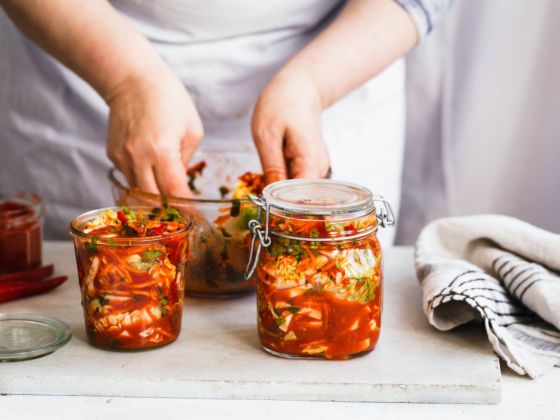Working as a volunteer on organic farms around the world, I enjoy picking my fruits and veggies, preparing my own food, and preserving them without freezing and/or canning. For thousands of years, our ancestors used fermentation to create foods with nutritional value far superior to that of the things most of us eat nowadays — the Sumerians worshiped beer; in the Arctic, fish was fermented to the consistency of mush; African tribes drank sorghum beer and ate fermented millet porridge.

Bill Mollison, one of the founders of permaculture and author of The Permaculture Book of Ferment and Human Nutrition, wrote that we probably co-evolved with the microorganisms used in culturing foods, which we have carried with us wherever we’ve migrated. We are always in a mutual relationship with most of these microorganisms, and they play a key role in the balance of our body, especially working for the digestive system.
My growing curiosity along with my scientific background brought me to investigate this fascinating world and to experiment with fermentation.
As I discovered the great benefits of the ancient practice, I wondered why fermented foods are not so often commercially available in the West. Instead, the processed food industry is actually manipulating, adulterating, and irreversibly treating the original ingredients of food products through chemical processes. For instance, Americans used to make lacto-fermented ketchup and relishes at home. Now they annually consume a half billion bottles of ketchup containing no live enzymes, but distilled vinegar and a large amount of high-fructose corn syrup.
Commercial pickles are not fermented, but made with vinegar, and commercial sauerkraut has been pasteurized. Pasteurization is a process of heating a food, usually a liquid, to high temperatures in order to reduce the viable pathogens and destroy all the enzymes as well — enzymes which help the body absorb important nutrients.
Modern commercial dehydration methods oxidize cholesterol in powdered milk, rendering it harmful to the arteries, and high-temperature drying also creates large quantities of nitrate compounds, which are potent carcinogens. But that is not all that pasteurization does to our food. Heat alters the range of the amino acids lysine and tyrosine, making the whole complex of proteins less available. It promotes rancidity of unsaturated fatty acids and destruction of vitamins. Simply put: It is unhealthy.
My experiments
The rustic kitchen of an organic farm in a remote village of Panama became my personal laboratory. I created special bubbly brews, cheese, and delicious pickles for my astonished travel mates. And this was just the beginning.
I was incredibly surprised by the various gourmet foods that are possible to create with the ancient technique of fermentation. I started with a simple recipe, enthusiastically changed some ingredients, and used the veggies from our garden. After a chat with a volunteer at the farm, I realised that a squash-like vegetable was growing quickly and wildly in our garden beds, but no one was excited to eat it because of its bland flesh. Chayote is an edible squash native to Mesoamerica, easy to find almost everywhere. I used a traditional German sauerkraut recipe, and prepared the chayote the following way:
Sauerchayote recipe
Ingredients (for 4 liters):
2 kg chayote
3 tablespoons of sea salt
1 head of garlicProcess:
- Chop or grate chayote, finely or coarsely, and place it in a large bowl as you chop it.
- Sprinkle salt on the chayote as you go. Use more salt in summer, less in winter.
- Add garlic and other vegetables if you like (carrot, cabbage, Brussels sprouts) or herbs. Experiment!
- Mix ingredients together and pack into crock and tamp it down hard. This helps force water out of the chayote.
- Cover chayote with a plate or lid that fits snugly inside the crock. Place a clean weight on the cover. Then, cover with a cloth to keep dust and flies out.
- Press down on the weight to add pressure. Continue doing this periodically (every few hours) until the brine rises above the cover.
- Leave the crock to ferment in a cool basement or in a safe corner.
- Check chayote every day or two. The volume should reduce as fermentation proceeds.
Timeframe: 1 to 4 weeks
Some useful tips for your own experimentation
Simple recipes can be found on the internet, and in most cases I buy or reuse a few jars or crocks and a culture starter. All are inexpensive tools and ingredients, available globally or reproducible. As a beginner, I started with basic recipes like sauerkraut and vegetable fermentation. Keep it simple.
During my travels, I discovered old-fashioned recipes and indigenous cultures who fermented food. For example, the Swiss eat fermented dairy products; Scots ferment cakes; the French love wine and cheese; Russians drink rye Kvass and kombucha (fermented tea). In some Asian regions, soy sauce, miso, sake, pickled ginger, daikon radish, and other vegetables are essential, and in Korea spicy kimchi is the national dish. I explored, took note, and experimented.
Do live fermented foods contribute to a long, healthy life?
The folklore of many different cultures correlates longevity with foods such as yogurt and miso, and many researchers have found clear evidence to support this connection. As a biologist and as a rational being, I don’t think we can reduce the secret of a long life to just one product or practice. Life is full of variables, and every person is unique.
That said, I believe fermentation is an everyday miracle; it is the joyous way of incorporating the wild into our bodies and becoming one with the natural world. This renewed harmony is, ultimately, the secret spice of my happy, healthy life.